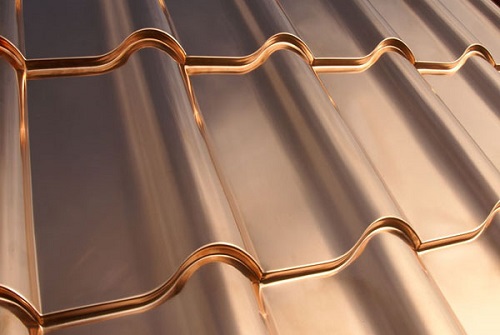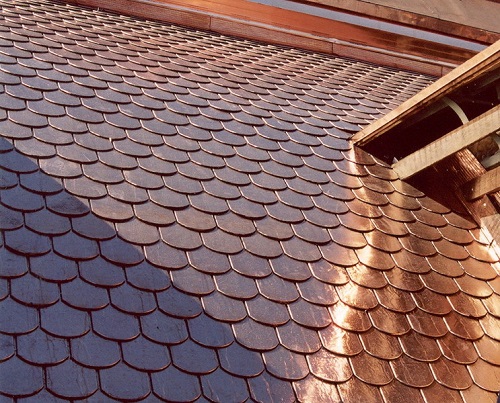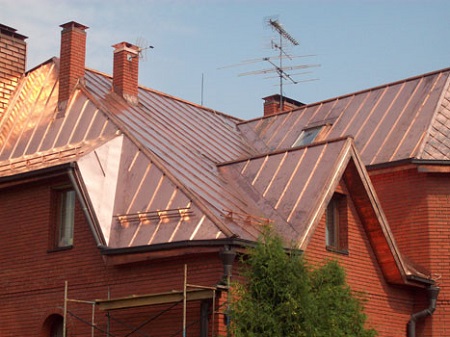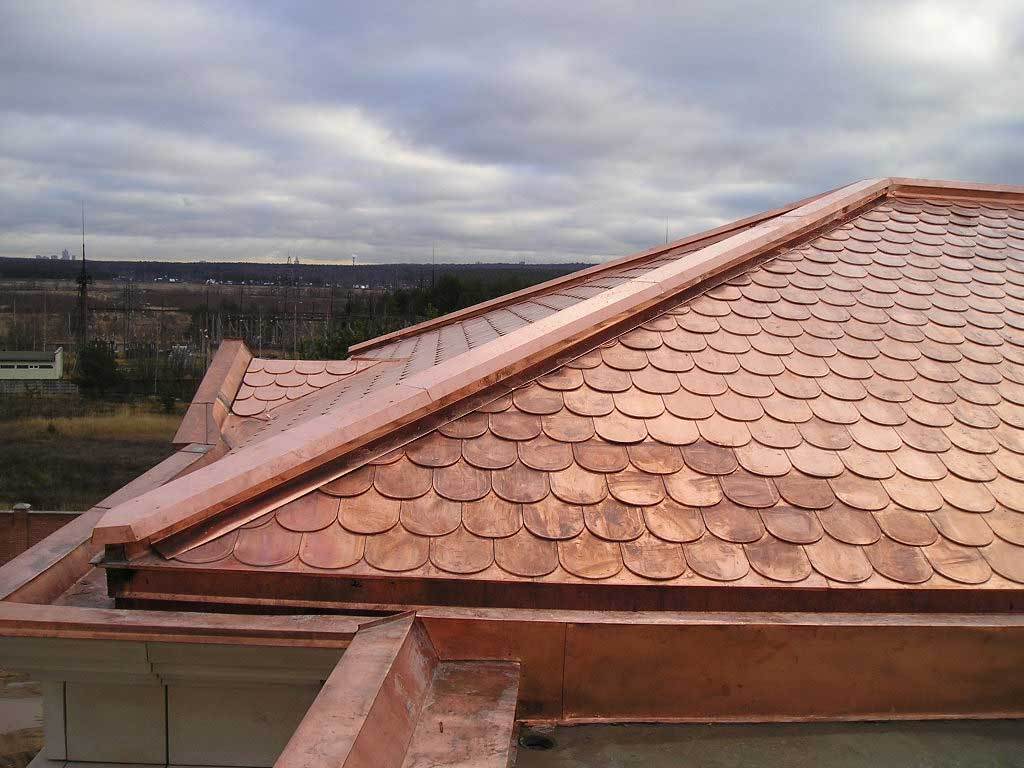Today, copper roofing is one of the most popular materials for roofing. It is distinguished by its strength, durability and stylish appearance. This article will talk about the features of copper roofs, their varieties and the main stages of installation.
Content
Briefly about the roof of copper

The copper roof is made of copper tape or a whole sheet. Roofing copper is manufactured by both domestic and foreign manufacturers. It can be of various thicknesses from 0.5 to 0.8 mm.
Compared with zinc, titanium, polymer and others, it is most environmentally friendly. During its operation does not emit any harmful compounds. In addition, over time, copper only strengthens due to oxide. This is the thinnest layer that can be noticed by observing the color change of the roof over time, does not allow oxygen to get to the metal, which slows down the wear process. The copper roof has a high degree of tightness, as well as resistance to temperature extremes and corrosion.

A completely new copper roof glistens in the sun, a little later it appears a brownish tint. After about 5-7 years, copper acquires a very dark color, and after that it turns green. The speed of color change depends on the climatic conditions of the region.
An important feature is good thermal conductivity, which means that in the winter, heating of the roof is possible, which will prevent the formation of ice.
The plasticity of such a roof will significantly facilitate the work on its installation. So sheet copper will allow you to use unusual design ideas when arranging a roof.
The copper roof does not require cleaning, painting or repair during the entire period of operation (and it is quite rather big for it - more than 90 years).
Varieties of copper roofing
According to the production technology, roofing is usually divided into two large groups:
- Shingled copper roof (metal coating of individual elements of a small format, which are located by overlapping joints between them);
- Folded copper roof (more airtight construction due to the almost complete absence of transverse joints between the panels, as well as a special configuration of the longitudinal lock, which eliminates leaks).
The roof can be both factory and manual.
In addition, the copper roof differs in the type of copper used for its production: classic, oxidized, patinated, tinned and others. The cost of the finished roof depends on the method of its manufacture, as well as the thickness and type of copper tape used.
The modern range of copper roofing is very extensive, anyone can choose the roof to their taste. Since a copper roof is a very popular option, you can see a photo of it a little lower. They differ mainly in their geometric shapes:
- "Checker". This type of copper tile is usually made by hand, it can be made in any size suitable for the size of the copper sheet.
- "Scales." It is produced in factories by stamping from various types of copper. It is most often used as a decorative roof covering, as it does not always protect a house from weathering. But this kind of roof looks simply luxurious. The main thing during installation is to use good lining carpets.
- "Volumetric copper rhombus." It is made manually using special equipment from any copper and in any size.It protects both roofs and building facades.

Copper tile
- "Share". A kind of "Rhombus" with a vertical step to give the roof a certain volume. It is used most often when covering temples, but is also used in private construction. It is also made from any kind of copper.
- "Double Shingle". It features quite simple installation and reliability. In addition, the price is usually comparable to a copper roof.
- Copper roofing KME. Roof tiles used on roofs with a large slope and for facade work.
- The roof is in the form of bricks. It is made manually on special equipment from any copper.
- "Volumetric copper brick." A variation of the previous tile. Especially popular in Europe and the USA. Can be used to decorate the facade of the building.
- Individual copper roof. Roofing made by bending or stamping. It can have any appearance, everything is limited only by imagination and financial resources. It is made to order.
Typically, copper tiles are laid in two layers so that each top plate covers the joint of two underlying.

Using copper tiles, take care of additional sealing with special lining carpets.
When installing piece roof tiles on gentle slopes, a structure called "false roof" is often used. In this case, the tiled roof performs only a decorative function, and a level below is equipped with a full-fledged bitumen coating, designed to protect the house from external influences.
Used roofing copper
Most often in modern construction, copper CU-DHP is used. Its composition is similar to copper M1f (oxygen-free copper with a limited content of residual phosphorus) produced in Russia. It fully complies with EN 1172, "Copper and copper alloys, ribbons and sheets in the construction industry." This material is ideal for welding and soldering.
The optimum width of the seam roof is 60 cm. As already mentioned above, the thickness of the material can vary. Usually thicker roofing copper is used to clad the facade of a building. 1m2 this coating with a thickness of 0.6 mm weighs about 5.5 kg, and together with the necessary additional elements (cornice overhangs, junctions, etc.) - about 6.5-7 kg (depending on the complexity of the coating).
The most famous manufacturers of roofing copper in Russia
KME is one of the world's largest manufacturers of copper products. It has 18 enterprises throughout Europe and Asia. Brand name Tecu-copper for roofs and facades. The products of this manufacturer are distinguished by the accuracy of geometric parameters and the purity of the alloy.
Luvata is a Finnish concern. It produces both finished products and raw materials for the creation of facade and roofing copper panels.
JSC Kirovsky Non-Ferrous Metal Processing Plant is a modern enterprise with rich experience in the production of flat and round copper. Introduces a wide range of metal products to the market.
Copper roof: Basics of mounting a copper rebate roof
With the correct installation of the seam copper roof, the technological holes formed in the case of the installation of other roofing are completely eliminated. It is for this reason that the copper roof is absolutely airtight, and in design and connection of sheets is similar to a tin can.
Installation of the roof will require sufficient accuracy during work, so it is better to entrust the installation to professionals in their field. For a quality installation of a copper roof, the use of traditional or specialized electromechanical tools is necessary.

Before the construction of the roof, it is necessary to make a solid solid wooden flooring. Roofing copper is attached to it with the help of movable fasteners - clamps, which are resistant to sudden changes in temperature inherent in our native climate.So, when cooling, the roof will shrink, and when heated, expand, moving along the fastening places, but the copper roof will be completely tight, and at the same time fulfill its protective duties in relation to your home.
When installing a roof with a small angle of inclination (up to 12 °), a folded roof is the best choice, because roofing copper has excellent ductility and can be installed on a roof of any complexity.
Roofing copper has the only negative - a fairly high cost. But given its other advantages, you can ignore this drawback. And besides, with the durability of the copper roof, the absence of the need for periodic repair, such a roof can cost even cheaper than other analogues. That is why, if you need a quality, beautiful and durable building, opt for the best option - a copper roof.





Alas, no comments yet. Be the first!